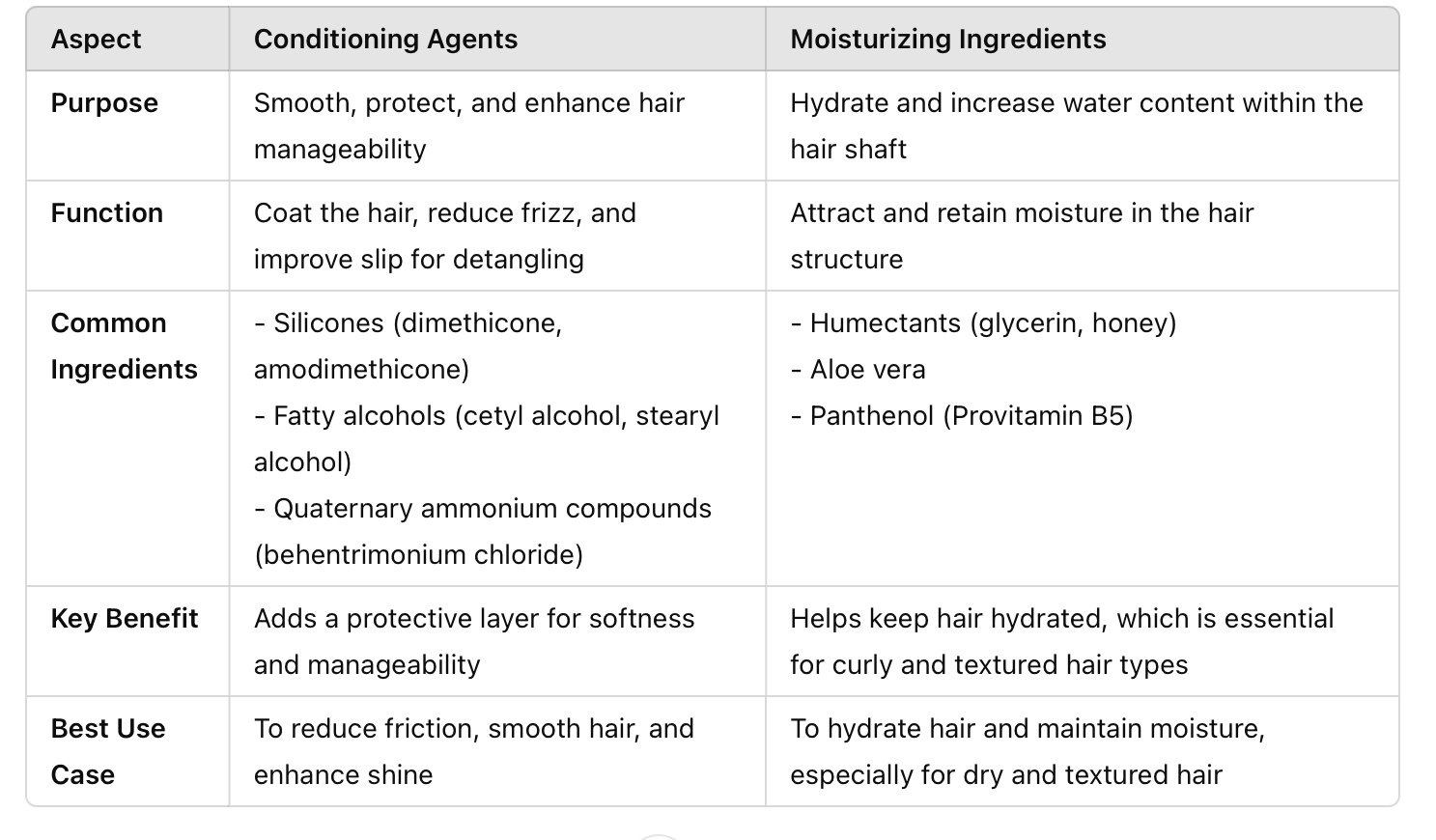The Difference Between Moisturizing Ingredients and Conditioning Agents: What Your Hair Really Needs
I have to admit…I was initially very confused when it came to conditioning agents and moisturizing ingredients because it all kind seemed like the same. Especially due to the fact that these terms are often times used interchangeably and also because some elements, such as emollients and humectants, are common between the two. Both are essential for healthy, hydrated, and manageable hair and work in unique ways. Here’s everything you need to know about these two crucial components of hair care.
What Are Moisturizing Ingredients?
Moisturizing agents are ingredients that add, attract, or retain water in the hair, keeping it hydrated, flexible, and soft. Moisturizers are particularly important for kinky, coily, and curly hair types, which are prone to dryness due to their unique curl structure, which makes it harder for natural scalp oils to travel down the hair shaft. Moisturizing agents work on a deeper level to boost water content in the hair and keep it from becoming brittle or breaking.
Types of Moisturizing Ingredients
Moisturizers can be divided into three main types based on their function:
1. Humectants: Ingredients like glycerin, hyaluronic acid, and honey that attract water from the air into the hair shaft, increasing hydration. These are excellent for adding moisture to hair but work best in moderate to humid climates. There is a deeper dive on humectants in this article.
2. Emollients: These are ingredients like natural oils (coconut oil, jojoba oil), fatty alcohols (cetyl alcohol), and butters (shea butter). Emollients help smooth and soften hair by filling gaps in the hair’s cuticle layer, which improves moisture retention.
3. Occlusives: Ingredients such as castor oil or silicones form a protective barrier around the hair shaft, trapping moisture inside. They don’t add moisture on their own but prevent water from escaping, making them effective in dry climates or for high-porosity hair that loses moisture quickly.
Benefits of Moisturizing Ingredients
- Enhanced Hydration: Keeps hair soft, flexible, and less prone to breakage.
- Frizz Control: Adds water to hair strands, reducing frizz and improving definition.
- Improved Elasticity: Moisturized hair can stretch and bounce back, which helps reduce breakage.
What Are Conditioning Agents?
Conditioning agents are ingredients that enhance the hair’s manageability, softness, and overall appearance. They work by smoothing the hair cuticle, adding slip, and strengthening the hair. Unlike moisturizing agents, which focus on adding water content to the hair, conditioning agents focus on keeping hair healthy, shiny, and tangle-free.
Types of Conditioning Agents
Conditioning agents generally fall into three categories:
1. Cationic Surfactants: Ingredients like behentrimonium chloride and cetrimonium chloride that reduce friction between hair strands, making them easier to detangle. They carry a positive charge that helps them bind to the negatively charged hair shaft, providing smoothness and reducing static.
2. Proteins and Amino Acids: Hydrolyzed proteins (like keratin and silk proteins) help strengthen hair by temporarily filling in gaps in the cuticle, which can improve resilience and reduce breakage. These are particularly helpful for damaged or highly porous hair.
3. Film-Forming Agents: Polyquaterniums and silicones create a protective layer on the hair shaft, improving shine, softness, and protection from environmental stressors. While effective, some film-forming agents (especially non-water-soluble silicones) may build up over time and need to be washed out periodically.
Benefits of Conditioning Agents
- Enhanced Manageability: Provides slip, reducing tangles and making hair easier to comb through.
- Smoothness and Shine: Helps the cuticle lay flat, reflecting light and creating a smooth, shiny appearance.
- Protection: Forms a barrier against environmental stressors, reducing the risk of damage from UV exposure, pollution, and heat.
Key Differences Between Moisturizing and Conditioning Agents
Why Your Hair Needs Both Moisturizing and Conditioning Agents
For optimal hair health, especially for textured hair, it’s important to incorporate both moisturizing and conditioning agents. While moisturizing agents hydrate the hair, conditioning agents ensure that this moisture is retained, while adding softness, slip, and shine. Using products that combine these agents or layering a moisturizing product with a conditioner can provide comprehensive benefits.
How to Use Moisturizing and Conditioning Agents Effectively
1. Layering for Hydration and Protection: Start with a water-based moisturizer or a humectant-rich product on damp hair, then follow with a conditioner or oil-based product that contains emollients and occlusives to seal in the moisture.
2. Deep Conditioning Treatments: Use a deep conditioner that combines moisturizing and conditioning agents once a week for textured hair. Look for ingredients like glycerin, aloe vera, and cationic surfactants to maximize hydration and manageability.
3. Adjusting to Your Hair’s Needs: High-porosity hair benefits from more conditioning agents (like proteins) to strengthen the shaft, while low-porosity hair should prioritize lightweight moisturizers and conditioning agents that won’t weigh hair down.
4. Climate Considerations: In humid climates, opt for film-forming conditioners and light humectants, while in drier climates, focus on occlusives and emollients to lock in moisture.
Conclusion
In short, while conditioning agents overall function is to add, softness and slip to the hair, improving it’s manageability, moisturizing ingredients are dedicated to regulate the levels of water (moisture) in our hair. Understanding the difference between the two helps you make informed choices for your hair type and lifestyle. Whether you’re looking to boost hydration, enhance manageability, or protect against damage, choosing the right products can transform your hair routine and keep your curls, coils, or waves in their best shape. By combining moisturizing and conditioning agents, you can ensure that your hair remains healthy, hydrated, and beautifully manageable.
Do you have any question after reading this article or would you like for us to take a deep dive on a specific topic? Let us know.

